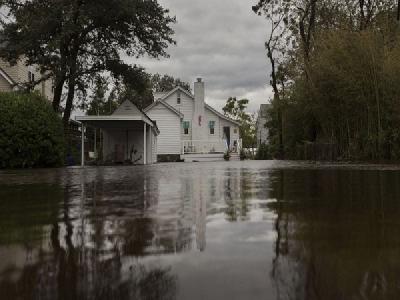
Posted on October 30, 2017
By Eric Hartley, The Virginian-Pilot
A federal study recommends more than $1.8 billion in upgrades to protect Norfolk from flooding, including new floodwalls, storm-surge barriers, living shorelines and reefs.
But there’s no money to fund any of it yet, and the final plan won’t be sent to Congress for consideration until 2019.
The proposals come in a draft feasibility report released Friday by the U.S. Army Corps of Engineers. It’s a key step in a “coastal storm risk management study” for Norfolk that has been planned since 2012.
“It’s a big study. It’s got recommendations that will take a long time to implement, so we’ve got to start now,” said Susan Conner, the policy and planning chief for the Corps’ Norfolk District.
The draft plan calls for extending the existing downtown floodwall north into West Ghent and east to Harbor Park and creating four new storm-surge barriers:
– Across the Lafayette River, from Norfolk International Terminal to the Lambert’s Point golf course
– Across Broad Creek, south of Interstate 264
– Across Pretty Lake, around Shore Drive in East Ocean View
– Across the entrance of the Hague
Floodwalls are permanent structures, while storm-surge barriers allow water to flow freely most of the time and are closed only during storms.
The plan, which can be read at www.nao.usace.army.mil/NCSRM, calls for living shorelines, reefs and greenways to absorb water and help protect areas not behind the new floodwalls or barriers.
Regardless of what gets built, the trends that sparked the Corps study aren’t going away: A state commission found nearly a decade ago that climate change is leading to more frequent and severe storms that produce greater flooding, even as the seas are rising and the land in Hampton Roads is slowly sinking or “subsiding.”
The Corps recommendations are based on a 50-year forecast for how flooding could affect every part of the city, including all 63,000 structures. The study suggests what fixes to fund based on the cost and how much damage they could prevent.
The analysis considered property values, but also historical, cultural and socioeconomic value, Conner said. Otherwise, neighborhoods with lower property values could go unprotected.
The draft report outlines just over $1.81 billion in upgrades and says almost two-thirds of the cost, or $1.18 billion, would be paid by the federal government. The other $633.9 million would be funded by the state or local sources.
But there’s no guarantee that Congress will fund the proposals – or that it would fund them all at once.
Corps and local officials hope to build protection before a catastrophe, but a secondary goal is to have the plans on the shelf and ready to go in case a major hurricane strikes Virginia. That could spur Congress to authorize emergency funding, as happened after Hurricane Sandy struck in 2012.
The $3 million Norfolk study was authorized in 2012 but didn’t get under way until 2016 because it was awaiting funding and its place near the top of the Corps’ priority list, Conner said.
As it was deciding on which steps to recommend, the Corps held a public meeting in June where residents could ask questions and give their opinions.
The draft plan now goes out for review, including public comment and reviews by Corps staffers around the country and independent experts outside the government.
Anyone can email comments on the plan to NorfolkCSRM@usace.army.mil.
After changes are made, the Norfolk Corps’ district commander will brief senior officials at headquarters on the updated plan. Then the Corps’ chief of engineers, the lieutenant general who oversees the entire agency, will send a final report to Congress in early 2019.
Source: The Virginian-Pilot





